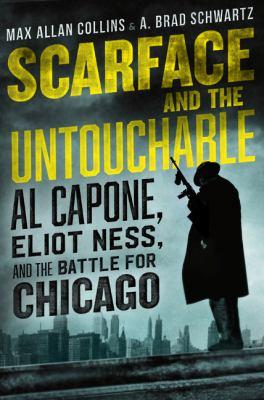
Scarface and the Untouchable : Al Capone, Eliot Ness, and the battle for Chicago
A THRILLING MAGNUM OPUS ON AMERICA'S GREAT CRIME EPIC. A Mystery Writers of America "Grand Master
Available Copies by Location
| Location | |
|---|---|
| Victoria | Available |
Browse Related Items
| Subject |
| Capone, Al, 1899-1947. Ness, Eliot. Gangsters > Illinois > Chicago > Biography. Organized crime > Illinois > Chicago > History > 20th century. |
| Genre |
| Biographies. |
- ISBN: 9780062441942
- ISBN: 9780062441959
- Physical Description xix, 699 pages, 8 unnumbered pages of plates : illustations, map ; 24 cm
- Edition First Edition.
- Publisher New York : William Morrow, animprint of HarperCollinsPublishers, 2018.
Content descriptions
| Bibliography, etc. Note: | Includes bibliographical references (pages 557-674) and index. |
Additional Information

BookList Review
Scarface and the Untouchable : Al Capone, Eliot Ness, and the Battle for Chicago
Booklist
From Booklist, Copyright (c) American Library Association. Used with permission.
Prolific genre novelist Collins teams up with historian Schwartz (author of the splendid Broadcast Hysteria: Orson Welles's War of the Worlds and the Art of Fake News, 2015) for this nonfiction portrait of legendary crime boss Al Capone and celebrated Prohibition Bureau agent Ness, who single-mindedly pursued Capone. We've seen this story, or variations of it, before, perhaps most notably in the 1987 film The Untouchables the historical inanities of which Collins can't abide but we've never seen it presented in quite this way. The authors' intent is to take two men who have been mythologized over decades, strip away the fictions that have been piled on them, and leave us with a clearer sense of the true Ness and Capone. And they succeed admirably. Collins brings all his skills as a novelist to the story, painting in bold strokes a picture of Prohibition-era Chicago, a city almost entirely under the control of Capone's criminal organization. His writing is about as far from a history text as you can imagine (the bullets shredded flesh, snapped bone, mutilated viscera, and spurted hot blood onto the cold concrete floor). Careful research combined with vivid pulp style.--David Pitt Copyright 2018 Booklist

Kirkus Review
Scarface and the Untouchable : Al Capone, Eliot Ness, and the Battle for Chicago
Kirkus Reviews
Copyright (c) Kirkus Reviews, used with permission.
A gritty dual biography reveals the underworld of crime and corruption in 1920s and '30s America.In 1923, Al Capone (1899-1947) and Eliot Ness (1903-1957) became neighbors on a residential street in Chicago. As award-winning mystery writer Collins (Executive Order, 2017, etc.) and historian Schwartz (Broadcast Hysteria: Orson Welles's War of the Worlds and the Art of Fake News, 2015, etc.) reveal, their careers soon vastly diverged. While Ness was a college student, Capone was involved in one of the city's major industries: crime. Within a few years, they would become fierce antagonists, Capone a notorious mobster, Ness a law enforcement agent focused on ferreting out bootleggers, especially Capone. By 1932, Capone had intensified into Ness' "obsession, consuming much of his time and energy." His team of agents, known as the Untouchables, became as famous in crime-fighting as Capone was in perpetrating crime. Like an urban hero, Capone was the first mobster depicted on a Time magazine cover. "He is, in his own phrase, a business man' who wears clean linen, rides in a Lincoln car, leaves acts of violence to his underlings," the magazine reported. Chicago tour buses pointed out his "old haunts." Law enforcement dubbed him "Public Enemy Number One," an epithet that became his "enduring nickname," rather than "Scarface," which he hated. Scrappy and debonair, he had risen to the status of myth, "a symbol of government ineptitude and incompetence" and "the breakdown of the rule of law." When he was finally tried for tax evasion, the courtroom attracted more than 30 journalists, including Damon Runyon. Jurors' deliberations, the authors assert, "boiled down to a question Chicagoansand so many Americanshad wrestled with through Capone's rise to infamous fortune: Was this man, this bootlegger, pimp, and killer, really all that bad?" The authors recount how Capone (the model for gangsters played by Edward G. Robinson and James Cagney) and Ness (model for Dick Tracy) took firm hold in popular culture.A fast-paced tale related with novelistic drama. Copyright Kirkus Reviews, used with permission.

Publishers Weekly Review
Scarface and the Untouchable : Al Capone, Eliot Ness, and the Battle for Chicago
Publishers Weekly
Mystery writer Collins (The Bloody Spur) and historian Schwartz (Broadcast Hysteria) dutifully trace the lives of Al Capone (1899-1947) and his lawman nemesis, Eliot Ness (1903-1957), in Prohibition-era Chicago. Drawing on a trove of sources, including Ness's scrapbooks, the authors look at the parallel arcs of these men in the 1920s and 1930s as Capone gained notoriety and status as Chicago's greatest public enemy while Ness climbed the ranks of law enforcement to head a squad devoted to bringing Capone to justice. The general contours of this real-life drama are familiar, including the irony that Capone was eventually convicted of tax evasion, rather than the hundreds of murders he orchestrated; the authors add depth to their depiction of both men with colorful details such as the fact that, prior to becoming adversaries, Capone and Ness both lived on South Prairie Street for a period in 1923. Collins and Schwartz present a balanced view of the role of Ness in capturing Capone, which accounts such as Jonathan Eig's Get Capone (2010) and Ken Burns and Lynn Novick's documentary Prohibition (2011) have largely dismissed. The result is an informed and valuable addition to the numerous books about Capone and Ness. (Aug.) © Copyright PWxyz, LLC. All rights reserved.


